innovation
The mindset shift towards A set of guidance fact sheets for ports



Since the world’s port community gathered at the IAPH 2022 Conference in Vancouver last May, our technical committees have continued working on their extensive programs with the aim of closing the gaps of port competitiveness in terms of both physical and digital infrastructure. Alongside our core themes of climate and energy, data collaboration and risk and resilience, the fourth major conference theme focused on business innovation. Innovation crosses the boundaries of all our three core IAPH themes and is the key to business improvement. As this white paper explains, innovation is not just about technology. A lot of it is about thinking differently. Different may not always be better, but better is always different.
This white paper The mindset shift towards innovation has been put together with the guidance of our Innovation Group Chair Gadi Benmoshe, with contributions from our valued members. Many of our contributors are actively participating in the work of the Data Collaboration Committee which is guiding the innovation initiative, headed by our Chair Pascal Ollivier.
I am grateful for their collective work in putting this whitepaper together and look forward to the next set of tools our IAPH Innovation Group will come up with to support our member ports in placing innovation at the forefront of their business strategies.
The next step of the industry call to action to accelerate digitalization :


Last June marks the second anniversary of a joint call to action coordinated by the International Association of Ports and Harbors (IAPH) with other industry partners to accelerate digitalization in the maritime supply chain. Since then, encouraging steps have been taken in providing a digital roadmap for ports, guidelines recognized by the IMO FAL committee on cybersecurity for
ports and port facilities and other initiatives such as the IAPH World Ports Tracker. Raising awareness, avoiding misconceptions, standardizing and promoting best practices as to how port communities can apply emerging technologies is part of that call to action. Succeeding in putting a smart idea into practice not only accelerates digitalization. More importantly, it can shift port executives’ mindsets towards innovation. This is the theme of the whitepaper Gadi and his Innovation Group team members have put together for you, as a first step in a series of actions to support innovation in ports.
Dr. Patrick Verhoeven, Managing Director, International Association of Ports and Harbors (IAPH)
At the beginning of this year, IAPH commenced its innovation journey by setting up a dedicated Group. We invited a number of innovation experts from ports around the world to take part and received an enthusiastic response. During our first group meetings we brainstormed on our goals and planned and prioritized activities.
We all believe that innovation, when shared, is an important tool that can address varying levels of efficiency and infrastructure quality at different ports.
Our first aim is for port colleagues to get a common understanding about the positive role innovation can play in their organizations. So we have designed this short, non-technical guide which explains this role, with practical examples from ports who have already commenced their own innovation journeys. From this basis we will build with further, concrete initiatives to support ports on innovation.
We have already seen with the compilation of this whitepaper that having different perspectives and expertise can accelerate the group’s activities. So I would like to encourage other ports to join the IAPH Innovation Group and take part in this exciting journey we have embarked upon where everyone has something to gain.

Ports are now evolving from their classic role of being predominantly landlords responsible for offering land concessions for the reception and handling of ships cargoes and passengers to serving their local economies and communities and forming a network of business hubs for global trade facilitation. Ports are one of the oldest and most traditional industries, so accepting and embracing innovation is often a slow process. However, in the last few years, ports from around the world have commenced their journey on innovation activities to improve their operational efficiency and
integrate new solutions to generate new revenue streams. One of the goals of IAPH, which gathers member ports from all over the world, is to close the gaps between the varying levels of port competitiveness and quality of infrastructure. Innovation is no exception and sharing knowledge is one of the main tools for reaching this goal.
This whitepaper has been compiled benefiting from the experience of many port innovation experts who are members of IAPH Data Collaboration Committee. Divided into easy-to-read sections that can be used as factsheets,
this document gives a snapshot and crib sheets for senior port executives who are serious about bringing in a mindset shift towards innovation in their ports.

The port sector needs to embrace innovation as part of its own transformation. Ports face multiple challenges, in a constantly-changing economic context, and must adapt to both new international and national regulatory requirements, strong international competition, accelerated digitalization and major climate and environmental challenges. An innovation strategy makes it possible for ports to adapt and reinvent themselves in what has now become a highly competitive and uncertain environment.
Avoid identifying the innovation tool first and manage expectations. Port innovation programs that ultimately fail to deliver are those which try to identify the tool for innovation such as hackathons first before figuring out what a port intends to achieve, which organizational and financial models should be put in place, and the ecosystem it should embed in a port community to ensure that innovation prospers and multiplies.
The timing of ports to commit and invest in a start-ups is an essential success factor. Ports often struggle to engage with the best startups due to the time constraints, delays and shortage of funds to support startups in latter rounds of investment. Ports need to streamline their innovation process. By meeting and supporting promising start-ups at their earliest stages, ports can improve the quality of starups that they attract.
Innovation can be applied to products and services, processes, organizational structures and the business models at ports; with technology enabling innovation rather than being a solution in itself. The focus has to be on the product, the service, the process or the business model and technology should become a driver for innovation. Not all innovation is technology-based.
For an innovation approach to be fully integrated into the port’s organization, the Chief Innovation Officer should report directly to the top management with cross functional access to all other departments. Other industries ahead of ports have learned this lesson. The innovation function should collaborate throughout all levels of the organization. This includes top management and the board to assure that innovation is aligned with corporate strategy and obtains the right funding.
An innovation ecosystem can only be achieved through a cooperative approach, with coordination mechanisms to facilitate interactions between different agents in the system. Open innovation fosters the participation, not only of the port itself, but also of the different agents of the port community, as well as of the innovation ecosystem linked to the port. This includes the creation of wellappointed committees or open working groups, both formal and informal, in which all the agents involved in the innovation processes may participate.
Selecting the right innovation tool depends on resources available, the ability to translate an innovation into a working proof of concept or pilot and committing to full implementation based on achievable success criteria. This will vary according to the port’s resource availability, but may start from a Proof-of-Concept (PoC) request to resolve a business problem, a hackathon to attract new talents and early start-ups or well-funded fully developed pilot projects with the correct mentoring and support.
The role of an innovation hub is to orchestrate facilities and tools to enable innovators to access and receive adequate support for their open innovation journey. These can potentially include (i) research and development and innovation centers to identify, investigate and explore new concepts and emerging technologies (ii) incubators and accelerators to nurture and develop, test and refine innovations (iii) testing facilities to create, prototype, validate and test innovations in real-life contexts (iv) training centers which are required for capacity building.
Funding is a crucial element for the innovation ecosystem. Long-term budget planning at an organizational level is needed. Funding sources may be available from government public tender notices, specific national or regional funds such as from the World Bank, the European Union, local innovation agencies, and private investment firms that have funds focused on different stages of start-up growth (seed, scale up, growth).
Ports should consider establishing Corporate Venture Capital (CVC) arms to support innovation. Establishing a CVC arm in ports is one of the innovation mechanisms that can generate revenue streams (in the long term) and can also increase the appeal of collaborating with the port. It can attract promising earlystage start-ups that are looking for value creation from their investors.
The innovation function should collaborate throughout all levels of the organization.

The ability to innovate is essential in a rapidly changing world. In a globalized, integrated and digital society and economy, all sectors of economic activity face intense competition that puts existing economic models under pressure and challenges the status quo. The ability to adapt to these rapid changes through innovation is an essential quality and skill for ports to respond to those changing models.
stakeholders. Through collaboration it is possible to process the logistics flow, and jointly deal with the multiple challenges faced in terms of safety, quality of service, performance, and sustainable development. The port community can mobilize its collective intelligence and its capacity for innovation to find appropriate solutions to each of the problems encountered.
The port sector needs to embrace innovation as part of its own transformation. The port sector has been traditionally conservative, focusing on cargo traffic and supply chain. Initially the onus has been port2port which nowadays has become door2door.
However, it now faces multiple challenges. In a constantly-changing economic context, ports must adapt to both new international and national regulatory requirements, strong international competition, accelerated digitalization and major climate and environmental challenges.This has led ports to work in adjacent business lines, beyond cargo traffic and supply chain, and to explore new opportunities.
An innovation strategy is required. To meet these challenges and adapt to this uncertain and rapidly-changing world, traditional strategies that are mainly based on investment planning, cost optimization and the search for profitability are no longer sufficient and expose organizations to risks. To meet these challenges, new strategies must be devised by ports. An innovation strategy makes it possible for ports to adapt and reinvent themselves in what has now become a highly competitive and uncertain environment.
The port is an ideal place to develop collaborative innovation. The port is both a place of exchange and intense activity, at the heart of the economic network of cities and regions. Ports bring together multiple public and private stakeholders who often share common objectives. This community of stakeholders have the opportunity to cooperate, to meet the challenges of globalization and the complexity of the supply chain.
Ports are in a logical position to nurture an ecosystem of companies and public
To ensure optimal coordination and real-time information sharing, some ports have set up digital platforms that bring together all the stakeholders involved in the supply chain. Port Community Systems (PCS), for example, have in many cases proven their worth as a tool of cooperation and collaborative innovation.
In realizing that innovation is essential, the Port of Hamburg has developed and implemented “homePORT” as a test area, “makerspace” within the port limits to serve as maritime real laboratory.
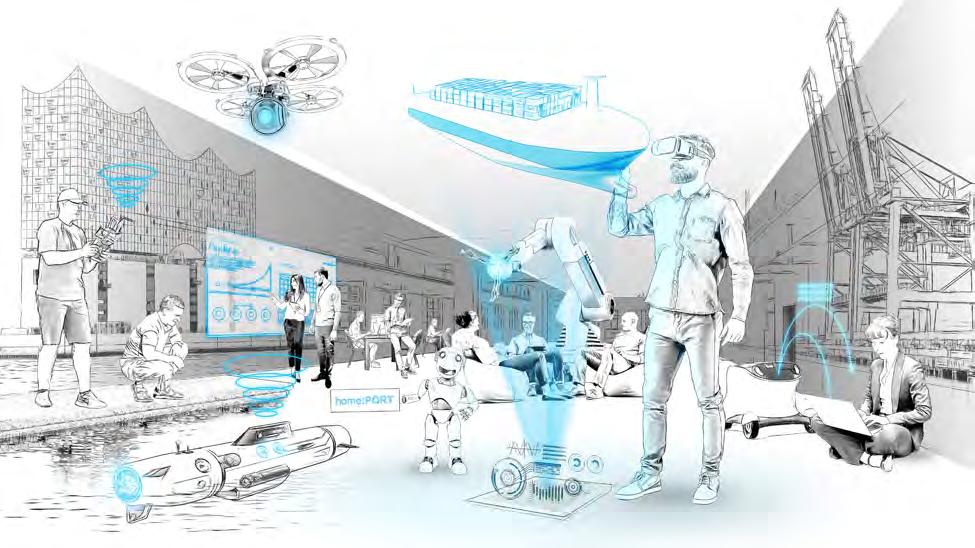
https://sustainableworldports.org/project/ hamburg-port-authority-homeport/
As an example, the Hamburg Port Authority is a partner of the EU-funded SeaClear project which will deploy autonomous underwater robots to detect and clear marine litter. The project won in the category “Environmental Care” at this year’s IAPH 2022 Sustainability Awards.
https://sustainableworldports.org/project/ port-of-hamburg-seaclear-project/

Innovation can be applied to products and services, processes, organizational structures and the business models at ports. Innovation can be applied to products and services (development of new products or services or improvement of those already offered), to processes (the way of obtaining these products or services), organizational structure (the way a port is managed and governed) or to the business model (the opening up of new markets). In the current context, this innovation usually has a technological component, but this is not always the case.
Technology enables innovation rather than being a solution in itself. The use of new technologies is a source of improvement, especially in innovation in products, services or processes, but it is not the only method. When it comes to innovation in business models, technology normally has a much lower weighting. The focus has to be on the product, the service, the process, the organization or the business model and technology should be an enabler for innovation.
Innovation management implies two functions –establishing a framework and the project management of initiatives. Innovation management implies two different functions. Firstly, the creation of framework conditions so that ideas are generated everywhere in the port and in the port community, at least among the port’s key stakeholders, and turned into successful innovations. This is mainly related to organization development in which developing a culture of innovation plays a vital role alongside the allocation of longterm budget planning throughout
the organization. Secondly, the active identification, selection, development, and implementation of ideas is needed with the appropriate resources. This is more linked to project management.

B2B Logistics Busan Barcelona Hub SL is a company created in 2022 by the ports of Busan (in Korea) and Barcelona (in Spain) to promote trade between Northeast Asia and Europe. The company is an innovative initiative between two ports to improve the logistics of exporters and importers between Korea and Southern Europe and it runs a logistics platform with added value services at the Port of Barcelona. This is an example of innovation in business models, since a new channel of activity via a new commercial company has been created which has not been carried up until now by either port authority. The creation of this limited company does not imply the specific use of technology, so should not be categorized as a technological innovation.
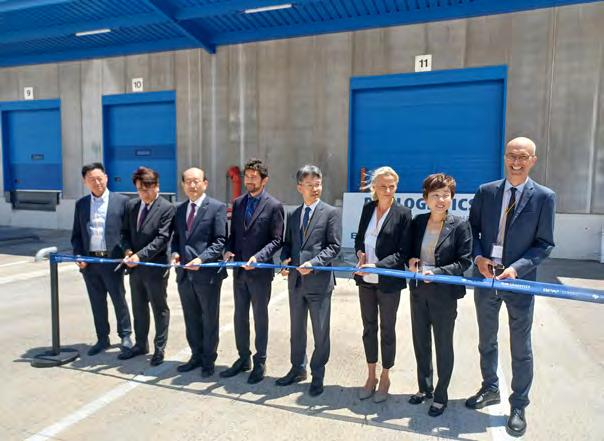

Innovation should not be exclusively considered as belonging to the Information Technology (IT) department. Since innovation is not exclusively technological, the innovation unit should not necessarily report into a port or port’s technology division (typically the IT department). It is more appropriate to highlight the crossfunctional and transversal nature of innovation if it has a direct dependence on senior management.
The role of a Chief Innovation Officer – a leader, process developer and collaborator. Chief Innovation Officers (CINOs) often lead their ports’ efforts to discover and develop new ideas for their port business and work to ensure that other executive officers recognize and support initiatives to encourage innovation. CINOs are not responsible for developing ideas themselves. Their role is to establish a process that enables other people in the organization to contribute. CINOs collaborate throughout all levels of the organization. This includes top management and the board to assure that innovation is aligned with corporate strategy and obtains the right funding.
CINOs need a direct reporting line to the top. In order to be able to integrate innovation into the port and accelerate the decisionmaking process, consistent and rapid access to the port’s top management (CEO/General Director) is needed. To guarantee this empowerment, the CINO and the innovation unit should report directly to the port´s CEO/ General Director. This is a lesson learned from other sectors that are used to adopting an open innovation model.
Required skills for an innovation leader – collaborative, integrative, enabling and inclusive. To efficiently lead an innovation team, the perfect CINO requires a personal profile which is fundamentally collaborative, integrative (to ensure effective collaboration), enabling (to involve all potential players in the port’s ecosystem) and inclusive (to involve all the potential surrounding ecosystem). It is highly recommended to seek complementary profiles with a combination of these traits.
The open innovation approach and developing an innovation ecosystem can only be achieved through a cooperative approach, with coordination mechanisms to facilitate interactions between different agents in the system. The term ‘innovation ecosystem’ was defined by Jackson (2011) as the “complex relationships that are formed between actors or entities whose functional goal is to enable technology development and innovation”. This term is becoming increasingly popular as the ‘open innovation’ model, coined by Chesbrough (2003) and has become a major growing trend.
Contrasting with the traditional closed model where companies innovate with their own resources and internal Research and Development (R&D) processes, open innovation looks for new technologies and ideas outside the boundaries of the firm. This also allows for the development of ideas that do not typically fit with the given strategy of the port.
Open innovation requires a cooperative approach with coordination mechanisms to facilitate multiple interactions and relationships between the different agents of the system. This varies from companies
(including suppliers and competitors) to knowledge centres and institutions, which act jointly to achieve common and shared goals. This is the logic behind the concept of the innovation ecosystem.
The development of the concept of open innovation needs to enable and foster the participation, not only of the port itself, but also of the different agents of the port community, as well as of the innovation ecosystem linked to the port. Ports are no stranger to these trends and a number of them are working to develop powerful innovation ecosystems around them to make this happen.
The most common strategy to integrate open innovation is the creation of wellappointed committees or open working groups, both formal and informal, in which all the agents involved in the innovation processes may participate. Also, these groups can establish additional collaboration and data sharing opportunities.
Adapting procurement processes to engage with startups. In many ports which follow national procurement regulations, signing agreements with start-ups is a complicated and time-consuming process. For a start-up these longwinded processes can sometimes become a major risk. One of the important roles of the CINO is to minimize the time required for these processes by arranging the required framework in cooperation with the legal and procurement departments.
Effective collaboration is key to guarantee an efficient innovation model. Effective collaboration is key to guarantee an efficient innovation model. Port processes are complex and affect multiple agents in the community, so
improving products and services must involve the participation of all those related to that product or the service. Collaboration between the parties is essential. It is also important that all stakeholders involved mutually understand each others’ processes and the collaboration areas and connecting points between them are clearly defined.
Collaboration with research institutes and structures for the development of new technologies. CINO teams’ relationships with universities, knowledge centres, laboratories and organizations are vital in conducting research in areas of interest to the port. Start-ups, tech companies, investment companies and collaborative platforms for the development of
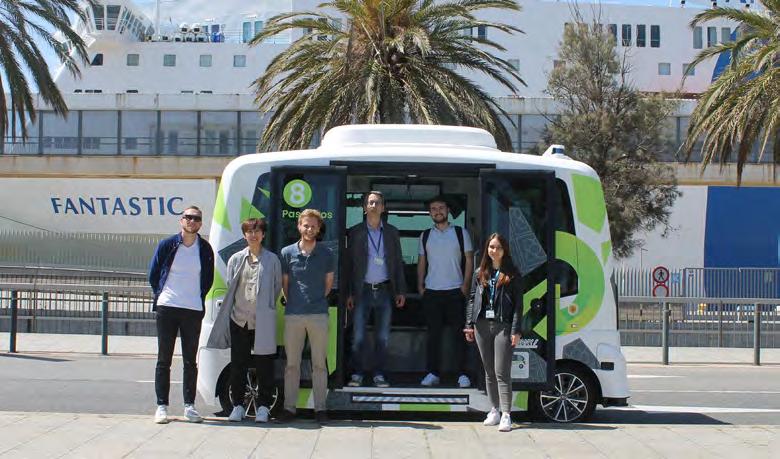

new technologies, accelerators and incubators are equally important. These platforms may sponsor research projects or provide facilities for startup companies to develop their Proof of Concept (PoC), they evaluate the tests and in case of positive feedback, they champion the new product or service to be developed.
The Port Authority of Barcelona created its innovation department in 2021. This department reports to the director of innovation and business strategy, who in turn reports to the presidency. The aim is to ensure innovation is truly cross-functional. Likewise, the port authority has created advisory working groups related to innovation: internally, it has an “R&D&I committee” (research development and innovation) made up of one member from each of all the operational areas of the port authority plus a representative from Portic, the Port Community System operator. Externally, it has created an the “innovation and strategy working group” with participating shippers, logistics operators, shipping companies, port agents, public administrations, the academic and research sector, as well as innovation hubs from the city. Barcelona is also in the process of creating a private foundation to accelerate innovation in its port.
Avoid identifying the innovation tool first and manage expectations. Perhaps one of the classic faux pas or well-intentioned initiatives in the field of port innovation that ultimately fail to deliver are those which try to identify the tool for innovation first before figuring out what a port intends to achieve, which organizational and financial models should be put in place, and which ecosystem can be embedded in a port community to ensure that innovation prospers and multiplies. The first valuable advice is therefore to read the preceding chapters and adopt some of those recommendations before considering the ones outlined here.
Expectation management is also key to ensuring that the tool achieves the goal as perceived by the stakeholder (start-up/innovator, the innovation hub/port authority, port community sponsor, and/or the wider benefactors of the innovation in question). Whereas a start-up with limited funding will eye with enthusiasm a monetary prize for winning a Hackathon with the promise of a pilot project, a more mature startup or well financed innovator with a couple of successful proofs-of-concept under its belt will most probably turn either away from an offer to take part or try to adapt their solution to one of the challenges to publicize their brand.
The broad consensus points towards deploying a mix of tools to attract
innovation to ultimately a) foster a cultural change in attitude towards innovation by a port b) to increase revenue and reduce costs and c) to identify and attract talent.
Selecting the right tool depends on resources available, the ability to translate an innovation into a working proof of concept or pilot and committing to full implementation based on achievable success criteria. Quite often, simplifying the process from defining the challenges the port is faced with to selecting an innovator to potentially deal with that challenge based on a tangible solution or idea is advisable, especially in the case of smaller ports with limited internal resources. A well- crafted communications and multi-media plan is advised to attract innovators to come up with specific proposals which then leads to a selection process followed by a well-financed, proof of concept project with a time stamp (e.g. for six months). This needs to be supported internally by the key players (e.g. Information Technology, Process Management, Human Resources, Operations, and even the dock workers union). This can potentially attract a variety of solution providers with varying degrees of maturity.
Winners from a “pitch battle” during a hackathon responding to various challenges put forward by a port, its tenants, service providers, or even
its shipowner-operator clients to students or early start-ups can be very successful provided adequate resources and planning are committed beyond the event itself. Unless a port has ample marketing resources, hiring a professionally-organised local specialized events management bureau for this approach is also advisable.

The implementation and success of a pilot project will often depend on the parameters defined and agreed to by all parties, how available the key players make themselves to set up the pilot, the pre-agreement on financing and risk (in some cases the realisation of a proper pilot can run into millions of dollars in a very short time) and the commitment to adopt full implementation based on achievable success criteria.
3Ensure adequate follow-up and support for innovators. Finally, the subscription models often encountered in port incubators where innovators get the chance to be introduced to potential clients will only be successful if there is a proper mentorship program in place, the key sponsors (which are often invisible and only demand results) commit actual resources to play out the pilots, and key individuals in the start-ups are not headhunted during the process by any party. Also, the promise of money and its actual timely delivery (especially from public funds with the governance procedures involved) should be taken into account.

In Morocco, the National Ports Agency (ANP), in partnership with the Global Alliance for Trade Facilitation of the World Economic Forum, organized a 100% online Hack athon for the first time in 2021 which inspired more than 500 participants and 30 countries from Africa, Asia, Europe and America to meet 7 port challenges. With the success of this edition, new forms of cooperation without borders or geographical constraints are surprisingly accessible to those interested in solving complex challeng es that handicap the international supply chain or threaten sustainable development. Open network innovation is therefore an excellent opportunity for all countries and all ports in search of meeting these challenges.
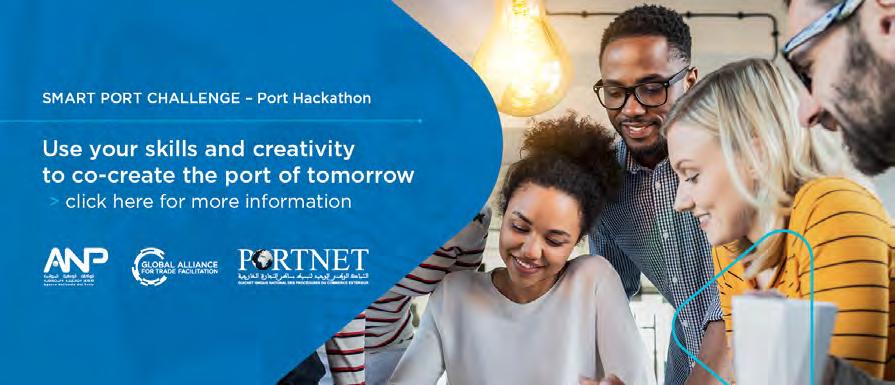

The role of an innovation hub is to orchestrate facilities and tools to enable innovators to access it and receive adequate support for their open innovation journey. The open innovation hub may include, but not be limited to infrastructure for research & development, incubators & accelerators, testing facilities, training centres and investment funds.
Research and development and innovation centers identify investigate and explore new concepts and emerging technologies. The promotion of innovation and the design, implementation and execution of R&D&I (research development and innovation) projects is a first stage for improving the competitiveness of companies and institutions in the sector and generating ideas that can be turned into new startups. The main role of universities, laboratories and tech-centre institutes is to identify, investigate and explore, together with the ecosystem partners, the use of new concepts and emerging technologies.
Incubators and accelerators nurture and develop, test and refine innovations. The availability of incubation services is relevant for ports, as it enhances the survival and growth of new ideas and startups. They promote the connection between the team leading the initiative and the port community. Incubation is a time during which innovation is being developed, tested, and refined to achieve a viable and marketable status.
Testing facilities create, prototype, validate and test innovations in real-life contexts. Test facilities for new products, services, and technologies (in some cases referred to as ‘labs’) are also crucial for the success of innovation in ports. Such laboratories can be regarded as places where various stakeholders collaborate in the creation, prototyping, validating, and testing of new technologies, services, and products in real-life contexts. These laboratories can be at the port premises, at universities or in private institutes.
Training centers are required for capacity building. Identifying port community knowledge gaps and offering specialized training with high added value for capacity building is vital. Continuous improvement of human capital of the port logistics community is an important pillar of the ecosystem. Without wellprepared and trained people innovation will have difficulty flourishing.



Fundación Valenciaport was launched in 2004 as an Applied Research, Innovation & Training centre providing services to the port and logistics cluster. This initiative of the Port Authority of Valencia has had the collaboration of notable businesses, universities and institutions from the port community. Since then, a strong innovation ecosystem has developed where port community companies collaborate with research centres, technological companies and institutions to develop innovative projects. In 2022 OPENTOP launched the Innovation Hub for the Valenciaport Cluster. This initiative complements the previous activity of the Fundación Valenciaport with a specific incubation and acceleration program for the port and logistics sector, venture capital to invest in high-growth startups and the development of laboratories and sandboxes to facilitate the testing and piloting in a port environment.


Funding is a crucial element for the innovation ecosystem. Investment funds are a crucial element in maintaining the activities of an innovation ecosystem. This funding can come from several sources, the most common being public notices from governments (as is the case of the Spanish Port Fund – Puertos 4.0, local innovation agencies and other public entities, as well as the World Bank or the European Union project funding). Those private investment/venture capital firms that have funds focused on different stages of start-up growth (seed, scale up, growth, etc) are also potential funding partners.
The timing of ports to commit and invest in a start-ups is an essential success factor Due to the time constraints and delays found in a largely traditional industry, and often the lack of funds to invest in latter-stage rounds, ports have struggled to engage with the best start-ups. It is therefore essential that ports streamline their innovation process. By meeting and supporting promising start-ups at their earliest stages, ports can improve the quality of start-ups that they attract.
Ports should consider establishing Corporate Venture Capital (CVC) arms to support innovation. Establishing a CVC arm in ports is one of the innovation mechanisms that can generate revenue streams (in the long term) and can also increase the appeal of working with the port. It can attract promising early-stage start-ups that are looking for value creation from their investors.
Choosing government-backed organizations as investors is an interesting option considering the economic slowdown of the private sphere. As such, the port can provide a unique, stable funding opportunity for start-ups in turbulent times. It is for this reason that now is the perfect time for ports to consider opening up a CVC arm to early-stage start-ups.
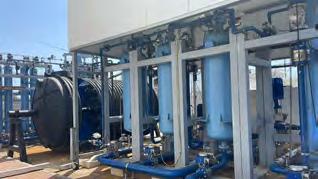







IAPH would like to thank the following member colleagues for their contributions to this white paper The mindset shift towards innovation :
Roy Avrahami - Chief Innovation Officer - Ashdod Port Company, Israel
Gadi Benmoshe - Chair – Innovation Working Group, Data Collaboration Committee and Managing Director, Marinnovators
Michael Bergmann - Owner, Executive Advisor - Bergmann Marine, Germany
Thierry Ducellier - Executive Head of Sales, Sinay, France
Salvador Furió - Innovation & Port Cluster Development Director, Fundación Valenciaport, Spain
Tarik Maaouni - Chief Information Officer, The National Ports Agency, Morocco
Jonas Mendes - Senior Consultant & Project Director - Port Strategy and Innovation Fundación Valenciaport, Spain
Carles Rua – Head of Innovation, Port of Barcelona, Spain
Estefania Sanles - Project Innovation Leader, Port of Barcelona, Spain
Victor Shieh - Communications Director, IAPH
If you would like to know more information about the IAPH Innovation Group or also become member of the Group, please contact: t_suzuki@iaphworldports.org
International Association of Ports and Harbors (IAPH)
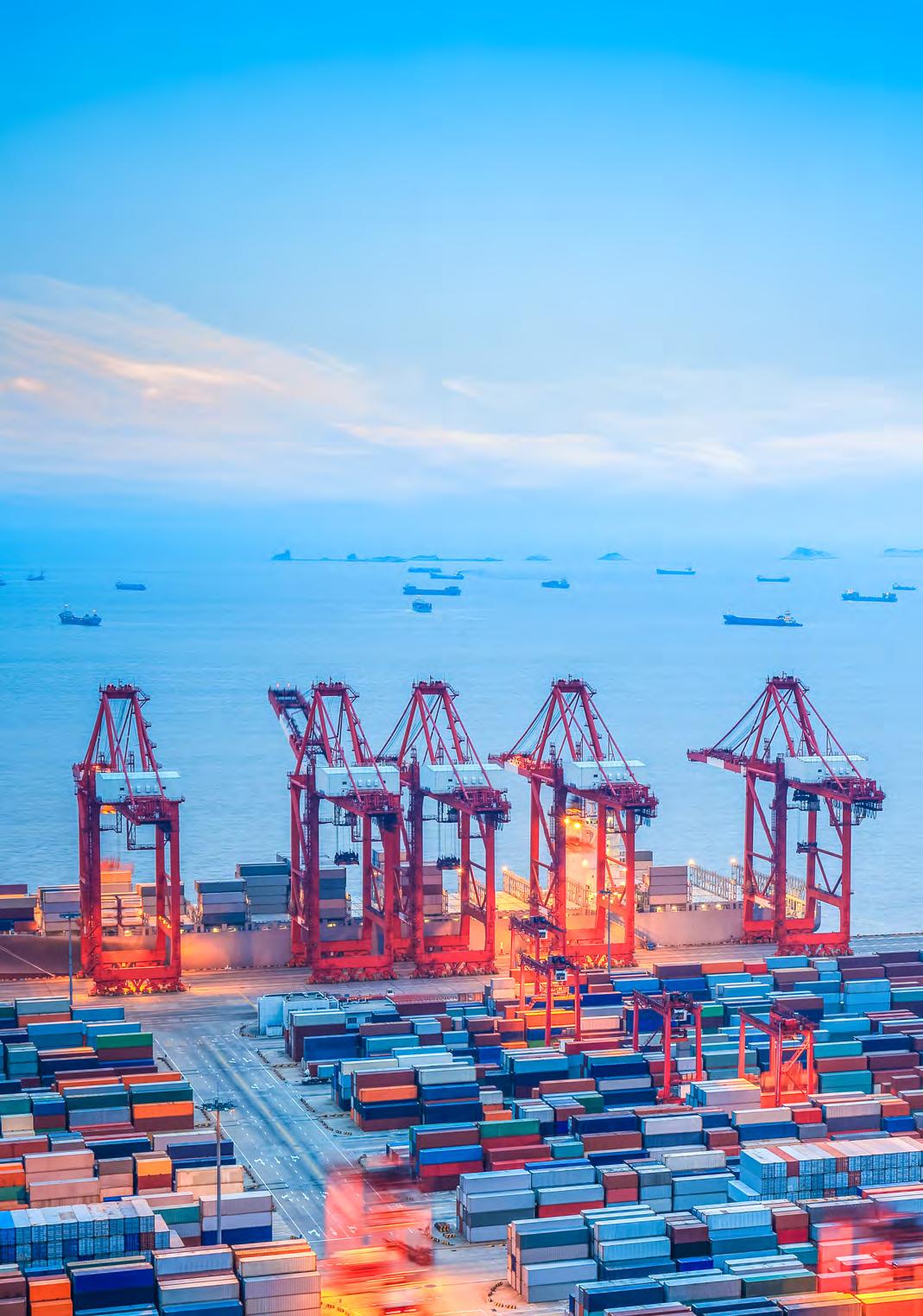
7th Floor, South Tower New Pier Takeshiba, 1-16-1 Kaigan, Minato-ku, Tokyo 105-0022, Japan Website : https://iaphworldports.org
Tel: +81-3-5403-2770
Fax: +81-3-5403-7651